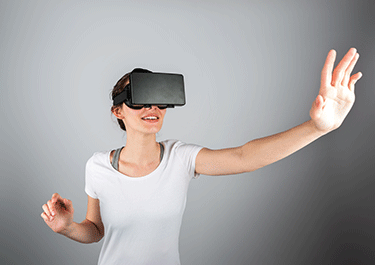 Imagine putting on glasses and seeing a virtual pile of boxes in front of you. Then imagine the glasses give you the precise measurements of the boxes, how much they weigh and even a detailed example of how you could pack the boxes on a pallet for ultimate efficiency.
Imagine putting on glasses and seeing a virtual pile of boxes in front of you. Then imagine the glasses give you the precise measurements of the boxes, how much they weigh and even a detailed example of how you could pack the boxes on a pallet for ultimate efficiency.
“It recognizes the world around you and does things in context,” said Alan Smithson, CEO at MetaVRse, who imagines a near future in which we’ll use virtual reality glasses that give us both visual clues and context for our digital experience. “When you start to have contextual AR – not just the box but the volume and weight as well — it gets really interesting.”
In the first episode of CompTIA’s Emerging Technology Community’s EM Cast, available on Blueberry, CompTIA VP Jim Hamilton talks with Smithson about the magic of AR, VR and what’s now being called XR.
“XR is the new term for immersive technologies,” said Smithson, who thinks a lot about this stuff and is writing a book to help people with related terminology and imagining the technology of the future.
“Imagine doing a keynote but not having to travel,” he said. “Or going to a conference and seeing someone’s name and also their LinkedIn and connecting on the spot. There are crazy efficiencies out there.”
Solution providers and MSPs stand to benefit from XR, Smithson said, because big corporations are taking a wait-and-see approach.
“The integrators are the ones who can really start to use this,” he said. For this reason, Smithson is looking at use-cases and how emerging technologies can be used to improve efficiencies and help companies make more money. “What you want to do as an integrator is learn these use-cases.”
MSPs and solution providers would be smart to focus on what is going in emerging tech so when customers start thinking about it they can be ready with a solution.
“We’re only scratching the surface of what’s possible,” Smithson said. In his company, he’s keeping up on Internet of Things, blockchain and eye-tracking, which he predicts will be vital to XR. “We’re teaching the fundamentals and empowering people to learn how to do it themselves.”
Smithson would like everyone, particularly young people, to get engaged with XR. “These are exponential technologies,” he said. “We want to inspire future generations to start thinking of these technologies.”
Follow MetaVRse online at @MetaVRse or search #MetaVRse. Click here for more information on CompTIA’s Emerging Technology Community.
To meet people working in emerging technology and members of CompTIA communities, attend the CompTIA Community Forum 2019. The next event will be held March 11 to 13 in Chicago. Register here.



2 comments
Hi Bradd, Thank you for reading the article and for your question. I had to reach out to one of Comp
Hi Bradd, Thank you for reading the article and for your question. I had to reach out to one of CompTIA's experts to assist with answering your question. Dr. James Stanger, CompTIA's Chief Technology Evangelist provide a long and short version of the answer. I will provide both to get a full understanding.Short:
Virtualization is where you use a piece of software called a hypervisor to abstract software, such as an operating system or application, from hardware. Using virtualization, you can use one computer to launch multiple operating systems or applications. Examples of virtualization software include VMWare and VirtualBox. Data centers and especially cloud providers use virtualization on a massive scale to provide services (operating systems and applications) to millions of customers worldwide.
Virtual Reality (VR) and Augmented Reality (VR) are completely different concepts. VR is where you create an entirely new, immersive environment. When you use a VR environment, you often put on those large glasses, and experience an entirely new world. With AR, you will see an environment that combines your existing world with a virtual element. For example, Pokemon Go is a common AR application.
Long:
Virtualization and AR/VR are two separate things.
Virtualization From a traditional standpoint, virtualization is where you run a separate version, or "instance" of an entire computer system from a software environment. In virtualization, you "decouple," or "abstract" the hardware from software. This makes software much more powerful. Let me explain. Normally, when you start a notebook computer, you wait until the Windows or Mac operating system launches, and then you log in and go to work using your Web browser, or Microsoft Word, or Excel, or other applications, right? Well, with virtualization, you install a software tool called a hypervisor. This tool runs on your computer much like any application, such as Chrome or Safari, or Microsoft Word. Companies that offer hypervisor software include VMWare, VirtualBox (my favorite, because it's free and powerful - just like me), or Microsoft Hyper-V. All you have to do is install this software on your computer. Then, you can use it to launch other operating systems right from your computer. Using my Windows 10 notebook computer, or example, I regularly launch a couple instances of Windows and Linux right from within my computer. They are fully-functional operating systems. The hypervisor software mediates between my host operating system (the Windows 10 system I use to work), and all of the "client" operating systems (e.g., the Windows and Linux instances I launched). The hypervisor makes sure that all of the clients work and play well together as they access memory, hard disk space, and networking services.
So, with virtualization, instead of tying one operating system (Windows 10) to a single piece of hardware (your computer), you now have the ability to launch multiple operating systems from one piece of hardware that all work at the same time.
About 20 ago, I worked with folks at IBM. They showed me how they could use a supercomputer that was about as large as a standard dresser to launch about 200 fully-functional Linux servers in their data center. That was pretty cool to see virtualization on an industrial scale.
Today, data centers and cloud services use virtualization on a regular basis to improve scalability, reduce expenses (virtualizing servers can save space, heat, and electricity). Cloud services (e.g., Azure, AWS, Google Cloud) can do more than virtualize operating systems. They can create "serverless" applications because they put virtualization an even more industrial, cool scale, by virtualizing just a database, or just a Web application, or just the necessary an artificial intelligence / machine learning application, such as Amazon Comprehend (https://aws.amazon.com/comprehend/).
Virtual Reality (VR) and Augmented Reality (AR) With virtual and augmented reality, you're talking about how smart applications can create an immersive experience by combining game-like environments with a person's actual environment. It is possible to create these environments using traditional installed software, or using software services from a cloud provider.
Virtual Reality (VR) is generally defined as an immersive experience that entirely replaces reality. Those glasses that you put on effectively transports you into an entirely new experience. Many games do this.
With Augmented Reality (AR), that immersive experience is not entirely different; your environment is a combination of your own world, and scenes provided by the VR application. If you've ever played Pokemon Go, you've experienced AR, because you see the "real world" in your phone, augmented by the Pokemon characters provided by the AR overlay. Most cloud providers offer VR and AR services. For example, AWS offers AWS Sumerian (https://aws.amazon.com/sumerian), which allows businesses to avoid re-creating the wheel. Using such services, organizations can launch their own immersive, interactive applications. These AR and VR services are made possible by - you guessed it - many thousands of virtual machines and (virtual) serverless applications! So, virtualization makes many things possible, including cloud-based AR and VR services that businesses increasingly use.Read full comment
What is the diff btw Virtualization & VR/AR? Hope this makes sense!